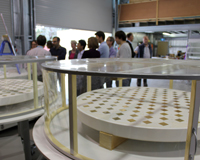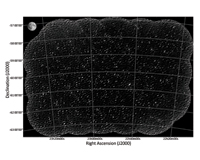Highlights and achievements of 2014
19 December 2014
What a year it has been for ASKAP (now officially a multi-award winning project), with many highlights seen throughout the year in early science and commissioning activities, significant advancement of ASKAP technological development, and progress in SKA pre-construction R&D activities.
A key highlight of the year for ASKAP Project Director Antony Schinckel has been the quality of data produced with the Boolardy Engineering Test Array (BETA) telescope.
“The productivity of the team in collecting data with BETA as we attempt to understand the intricacies of how to do astronomy with a PAF-equipped interferometer has ramped up enormously this year,” said Ant, “We will look back in a decade and see that ASKAP’s demonstrations of phased array feeds were a radical new approach to astronomy that significantly changed the field.”
Some of the science highlights for the year include:
- Continuum imaging and a 50 square degree image that revealed over 2000 sources
- The first spectral line ‘data cube’, and making that data available to the ASKAP Survey Science Teams
- Imaging of neutral hydrogen revealing the rotational velocity of galaxies
- Demonstrations of HI absorption science, transient observing capabilities and polarisation imaging
- Early science results that reflect the advantages of ASKAP’s unique capabilities, such as the antennas’ third ‘roll’ axis and the PAF's ‘steerable’ beams
- The first VLBI observations achieved with an ASKAP PAF
Major commissioning highlights saw the deployment of the Mk II PAF to the MRO and successful ground aperture array testing, which yielded impressive system temperature results for the enhanced receiver design. The installation of the first Mk II PAF on an ASKAP antenna also paved the way for the production of the next wave of PAFs to begin.
The positive sentiment was echoed by ASKAP Project Scientist Lisa Harvey-Smith, who noted what an exciting year it has been for the team.
“This is a time to reflect on the amazing things achieved by everyone – past and present – who have worked on ASKAP,” said Lisa, “for example, this year we saw the first science data from the BETA telescope going into the hands of astronomers, who promptly discovered a vast reservoir of hydrogen gas around the central core of a galaxy almost five billion years away.”
Looking ahead, there is still much to learn about the telescope itself, and the techniques required to use ASKAP for large-scale scientific surveys. 2015 will see production of Mk II phased array feed receivers continue to ramp up, first scientific observation with ASKAP-12, continued close work with the ASKAP user community to prepare for early science operations, the next stage of ASKAP’s science data archive, and continued involvement with the SKA R&D consortia working towards the design of the international SKA project.
For previous annual highlights, see: 2013, 2012, 2011.




